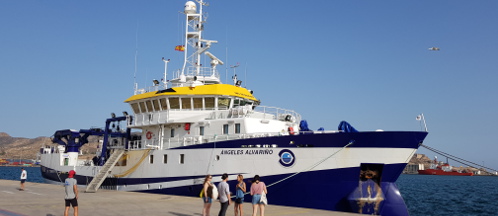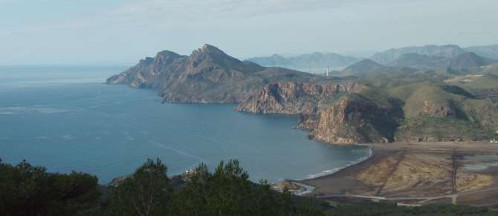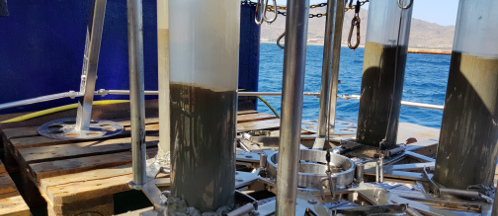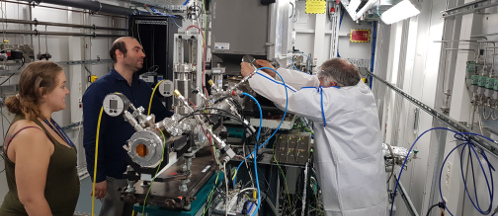Cerdanyola del Vallès, 14th March 2019. Very few people know about Portmán Bay, where took place one of the most extreme cases of coastal ecological impact by mine activity in Europe. Figures speak for itself: the mining company Peñarroya dumped more than 60 million tonnes of mine waste into the sea through a 2km-long pipeline located at the west part of the bay. Over the years, the bay became totally filled with a mountain of artificial sediment. The shoreline moved 600m seaward and the trace of the pollution reached 12km offshore.


Since the 90's there is no mining activity in Portmán but waste materials are still there. Now, samples have travelled to the ALBA Synchrotron to be analysed. Their story begins aboard the oceanographic ship Ángeles Alvariño, where the research group in Marine Geosciences of the University of Barcelona took samples of the sediments located under the sea. "So far, many scientific studies were focused on the emerged part of the waste of the Portmán beach", says Marc Cerdà, PhD student at the Department of Earth and Ocean Dynamics and a member of the research team. "We took material through perforation of marine floors with up to 4 meters tubes, and that is how we obtained samples of sediment cores". The analysis of these sediments confirms that they contain arsenic resulting from minerals extracted at the mine, such as arsenopyrite. Moreover, arsenic is found under different oxidation states. That is, this arsenic has suffered chemical transformations like oxidation, which can affect its mobilization and release by dissolution into the water. Researchers want to know to what extent these processes happen, since "until now almost nothing was known about that," explains Josep Roqué, professor of the Department of Mineralogy, Petrology and Applied Geology of the UB. "It is important to characterize these mining waste in the proper way to rebuild geochemical processes that alter minerals with arsenic and then, to defining the availability of this toxic element in the marine ecosystem" he adds.
Under synchrotron light
To find out exactly which geochemical processes occur at the Portmán Bay, first of all waste samples where characterised at the CORELAB laboratory of the UB. Secondly, the samples have been analysed at the ALBA Synchrotron, at the CLAESS beamline with X-ray spectroscopy technique: the material is "illuminated" with synchrotron light and, detecting the amount of energy that the sample absorbs and emits, it can be deduced which chemical elements form it and which their oxidation state is.
These sediment samples, that contain arsenic, have been prepared following a protocol specifically designed with CLAESS beamline scientists. Analysis under controlled conditions allows studying the sediments under the same ones in which they are in the bay; and therefore, obtaining faithful results. "CLAESS gives the means to measure in controlled conditions, without atmosphere exposure to avoid the risk of oxidation. If we precisely want to know the oxidation state of the elements in situ, we cannot allow for their alteration during the analysis" explains Carlo Marini, beamline scientist. In addition, CLAESS can detect chemical elements even if its concentration is very low in the sample. "This is the first time we have studied such a big question with these powerful tools and we are getting unprecedented information of Portmán," the scientists point out.


On the left, core samples of sediments extracted from under the sea on the oceanographic ship. Right: Miquel Canals putting sample supports, which were specifically designed and printed with 3D technology at ALBA, at the CLAESS beamline to be analysed with synchrotron light; with Carlo Marini, beamline scientist and Andrea Baza, PhD student from UB.
Researchers expect to find valuable hints on arsenic distribution among the sediments of Portmán to determine its mobility. It must be said that arsenic dissolution does not implies necessarily its availability for living beings. For example, after releasing into the water, arsenic can precipitate again and be fixed in the form of a new compound. In fact, so far there is no evidence that arsenic has reached the living organisms. According to Miquel Canals, head of the research group, "Portmán is an exceptional study case on which we still have more questions than answers, despite having made a great deal of progress regarding the knowledge of its stability, structure and composition; which are crucial aspects for planning remediation tasks and, as far as possible, the rehabilitation of the bay".
What remains of "Portus Magnus": a reference case study
Portmán was already an important location both for the Carthaginians and the Romans, who called it Portus Magnus. Now, Portmán is no longer an important port, it remains only a trace in the middle of the mining tailings. Nowadays, there is a rehabilitation project of the bay that aims to eliminate 10 million tonnes of waste and move the shoreline 300m back inland.
Nonetheless, Portmán could be useful as a reference case study of mining dumps impacts into the sea. Currently, for example, there is a relatively new mineral retrieval process, the deep sea mining: extractions 3000m in-depths under the oceans to bring minerals to the surface. So, study cases such as Portmán are very interesting to see what could happen when there is a big amount of processed mineral and tailings under the sea.
This project has been carried out jointly by the UB Departments of Earth and Ocean Dynamics and Mineralogy, Petrology and Applied Geology. The research time is formed by: Josep Roqué Rosell, Miquel Canals Artigas, Anna Sànchez Vidal, Jaime Frigola Ferrer, David Amblàs Novellas, Marc Cerdà Domènech, Andrea Baza Varas; with the collaboration of Museu de Ciències Naturals de Barcelona (Marc Campeny) and professor Joan Carles Melgarejo (UB).




